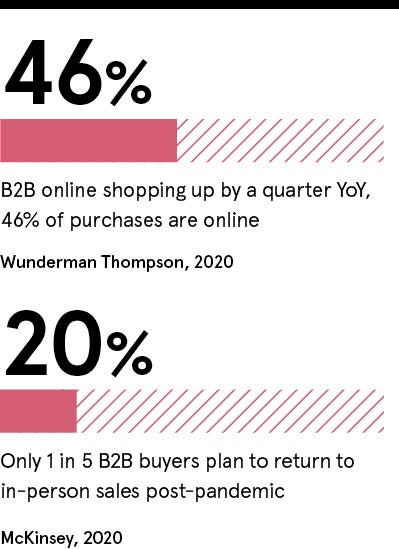
The events of the past 18 months have accelerated many organisations’ digital transformations by months or, in some cases, years. In particular, we saw a surge of investment in digital sales channels with in-person meetings and physical purchases no longer an option.
This has been reflected in a wave of online purchasing – both by consumers and in business to business (B2B) transactions. Indeed, B2B online shopping increased by almost a quarter last year, with 46% of purchases now made online. Additionally, more than three quarters of B2B buyers say they now prefer purchasing online and remote interactions with sales reps. Only about 20% of B2B buyers say they hope to return to in-person sales post-pandemic.
This has resulted in organisations making their purchases through more channels than ever before. As an example, online B2B marketplaces gained huge traction during the pandemic. Having already predicted that 17% of the $13tn in B2B spend would flow to marketplaces by 2023, analyst Forrester is now saying that we will hit that much sooner — perhaps this year.
Importantly, these purchases are not restricted to smaller-ticket items. Seventy percent of B2B decision makers say they are open to making new, fully self-serve or remote purchases in excess of $50,000, and 27% would spend more than $500,000.
The challenge of siloed data
This presents some new challenges for B2B organisations and their sales teams. For example, many suppliers have developed long-standing relationships with their customers – and this can often manifest into an expansive landscape of unique purchase terms and agreements with different customers. As tricky as managing these different scenarios were in-person, the situation has been further complicated with the switch to digital platforms.

In the effort to support all these digital channels, we’re seeing organisations end up with conflicting pricing information and data blind spots across the organisation.
“A lot of the data that’s required for those experiences becomes unintentionally siloed,” says John Bruno, vice-president of commerce strategy at PROS. “So your sales team uses one system that has certain prices for products, and in ecommerce there is a different system that uses different pricing for products.
“The more channels that you support, the more it creates more opportunity for information to be wrong and for the experience to break.”
This is a crucial point – the customer experience (CX) has never been more important than it is today, with purchasers reliant on online platforms to access products and services. Taking a lead from consumer sales, businesses today expect a frictionless experience and exceptional customer service – and if a supplier fails to impress, they won’t hesitate to go elsewhere.
Changing purchasing behaviour
Compounding the problem is that most customers today are more than halfway through the buying process before even meeting with a company representative. Much of the B2B customer’s research takes place on social channels, with 60% of buyers preferring not to communicate with salespeople as their primary information source. Being forced to engage much later in their buying journey means the window of opportunity for salespeople to influence customers is smaller.
“There’s many things happening outside the purview of the traditional salesperson,” says Bruno. “Even if you’re entering bright-eyed and bushy-tailed from an engagement standpoint, your customers are already 10 or 15 steps ahead of you. They’re already more informed when you start engaging with them. Without that context, you start telling them things they already know. That’s when frustration starts to settle in.”
It’s also how you deliver that data to your salespeople, so they can pick up the customer’s journey in stride and add value to it
This highlights another potential pitfall in the transition to digital channels – the need for sales teams to have insight into where a customer is on their buying journey. This is particularly relevant given that a typical B2B buyer journey may traverse multiple touchpoints within that journey. These data points provide context to the customer and the problems they’re trying to solve.
“It’s about getting the data right and exposing that data in a way that’s meaningful – for your buyers to be more autonomous, to do what they have to do more quickly, more easily and with more confidence,” says Bruno. “It’s also how you deliver that data to your salespeople, so they can pick up the customer’s journey in stride and add value to it.”
The ability to view what customers are browsing – and what they don’t – is a powerful one.
“Imagine if you added a bunch of items to a cart, and you abandon that. The signals are really powerful for a B2B salesperson to pick up and think, ‘maybe there’s an opportunity for me to reach out, based on what I know about you, to see if I can get you over that hump and get you to make the purchase.’ Those kinds of data insights are incredibly valuable for B2B,” says Bruno.
Digital technologies shaping the future
Many organisations are racing to digital – an obvious move in today’s climate. However, it would be far more valuable to them to do so in a thoughtful and pragmatic way, instead of simply standing up an ecommerce platform that will unintentionally create more data silos, says Bruno.
“Focus on the things that are always present, that are common across all of those channels. Spend more time looking at cleaning and readying your data, so it can be leveraged for this omnichannel world. Organisations that rush to the flavour-of-the-week experience or touchpoint tend to neglect that and they get themselves in a lot of trouble.”
PROS supports business in their transition to omnichannel and digital selling with an AI-powered platform that manages and optimises a business’ products and pricing, regardless of the sales channel, helping business to adapt to every customer and every transaction fluidly.
Ultimately, Bruno advises: “Are you putting the right product recommendations and prices in front of a customer? Are you helping the salesperson do a better job at connecting the value of your products to your customers? It’s a really exciting time to be in B2B and think about the role that digital technologies have in helping shape the future.”
Want to learn more about the PROS Platform and the B2B path to digital selling? Visit pros.com
Sponsored by

The events of the past 18 months have accelerated many organisations’ digital transformations by months or, in some cases, years. In particular, we saw a surge of investment in digital sales channels with in-person meetings and physical purchases no longer an option.
This has been reflected in a wave of online purchasing – both by consumers and in business to business (B2B) transactions. Indeed, B2B online shopping increased by almost a quarter last year, with 46% of purchases now made online. Additionally, more than three quarters of B2B buyers say they now prefer purchasing online and remote interactions with sales reps. Only about 20% of B2B buyers say they hope to return to in-person sales post-pandemic.
This has resulted in organisations making their purchases through more channels than ever before. As an example, online B2B marketplaces gained huge traction during the pandemic. Having already predicted that 17% of the $13tn in B2B spend would flow to marketplaces by 2023, analyst Forrester is now saying that we will hit that much sooner — perhaps this year.

